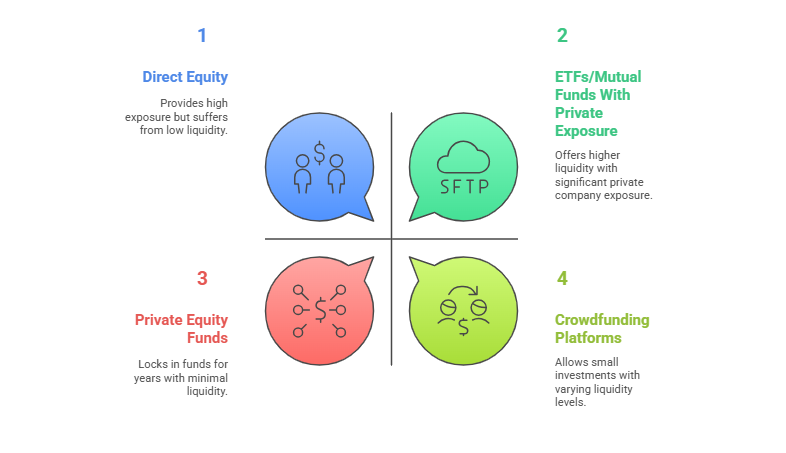
How to Invest in Privately Held Companies for Future Growth
If you’ve ever wondered how to invest in privately held companies for future growth, I’d love to share the steps I take. Investing in private ventures can boost my portfolio and support exciting ideas before they hit the public market. At the same time, it demands extra caution and thorough homework to manage higher risks. Let’s walk through the basics of private investing and see how I personally approach each phase.
Know The Basics

I like to start by clarifying the distinction between private and public companies. Public companies list their shares on a stock exchange, so it’s usually simple to buy and sell. Private companies, however, don’t make shares widely available, and sometimes only select investors (such as accredited or institutional) can invest directly (SmartAsset).
To complement my understanding, I review core terms and concepts. If you’re new to some of the insider language, consider checking out this quick overview of investment banking terminology. Familiarizing myself with key vocabulary means I can spot the risks and rewards more easily in any private deal.
Check Your Eligibility

Next, I confirm whether I qualify as an accredited investor. In many regions, private investments require meeting specific income or net worth rules. These measures aim to protect retail investors from high risks linked to non-regulated offerings. Alongside that, I examine if opening an individual investment account could streamline how I hold my private shares.
If I don’t qualify, indirect routes—like certain ETFs or mutual funds—might still offer a slice of the private market. According to SmartAsset, these funds may invest in private equity, so I get exposure without dealing with the complexity of direct ownership.
Research Thoroughly

Due diligence is non-negotiable for me. I start by identifying the company’s background, growth plans, management team, and potential market. Analyzing how it’s structured (debt vs equity) helps me see how returns may be paid out. I also check the company’s track record—has it pivoted multiple times, or is it steadily marching toward its goals?
I dig deeper into valuation. Private firms aren’t weighed by market prices the way public stocks are, so exploring historical funding rounds, share classes, or any mention in industry-specific reports is crucial (EquityZen). I also like to look at risk factors—delays in product development, regulatory hurdles, or macroeconomic conditions that could derail profits.
Choose Your Investment Path

Once I’ve gathered the facts, I decide how hands-on I want to be. If direct investing sounds good and I qualify, I can buy shares from founders or existing shareholders. Otherwise, I might try:
| Investment Option | Description | Liquidity |
| Direct Equity | Buy shares directly from the private company | Low, typically need a buyout or IPO to exit |
| Private Equity Funds | Pool money with other investors to invest in multiple private projects | Low, often locked in for years |
| Crowdfunding Platforms | Invest small amounts alongside other individuals | Varies, but usually still illiquid |
| ETFs/Mutual Funds With Private Exposure | Limited stake in private companies through specialized funds | Higher, but partial exposure |
If you’re aiming to start your own fund with partners or colleagues, it’s worth exploring how to form an investment fund. For business owners looking to raise capital, there’s also a resource on seeking investors for business.
Monitor And Adjust

After sealing a deal, I make sure to stay in the loop. Private firms don’t report quarterly earnings like public companies, so I rely on periodic updates from management or investor newsletters. I also keep a watchful eye on the potential for a liquidity event—like an acquisition or IPO—because that’s usually when I can realize a return on my investment.
If the company is struggling or veering off course, I may reconsider my position. In private investing, decisions can’t always be undone easily, so I typically approach these commitments with a long-term mindset (Wiss).
Quick FAQs In One Sentence

Wondering how to invest in privately held companies—do I need to be accredited, how much capital is required, do I need a specialized individual investment account, what level of due diligence is essential, and how do I eventually exit my investment?
Final Thoughts
My experience shows that investing in private companies can be an exciting way to accelerate wealth and support the ideas I believe in early. Still, I recognize it demands extra care. Before diving in, I make sure to research diligently, verify my eligibility, and stay in contact with the company’s progress over time. If you’d like more foundational insights on portfolio building, check out understanding investments or keep enhancing your investment education. With the right preparation, private investing can open doors to future growth—just make sure you step through them wisely.
Showcase your recognition by adding our award badge to your website! Simply copy the code below and embed it on your site to highlight your achievement.

Recent Posts
Investment Firms in Los Angeles to Consider
Los Angeles is home to a diverse and dynamic financial...
Investment Firms in New York to Consider
Choosing the right investment firm is crucial for achieving your...





